If you’re searching for the San Giorgio lasagna recipe, you’ve landed in the right place. This iconic recipe, famously printed on San Giorgio pasta boxes, has been a beloved classic in many households for decades. Whether you’re a beginner or a seasoned cook, mastering the San Giorgio lasagna recipe will elevate your culinary repertoire and bring authentic Italian flavours right into your kitchen.
In this comprehensive guide, we’ll explore everything from the origins of this traditional recipe to detailed cooking instructions and helpful tips for troubleshooting common challenges. We’ll also include nutritional insights, tools, and frequently asked questions to make your lasagna-making experience seamless and enjoyable.
Let’s dive in!
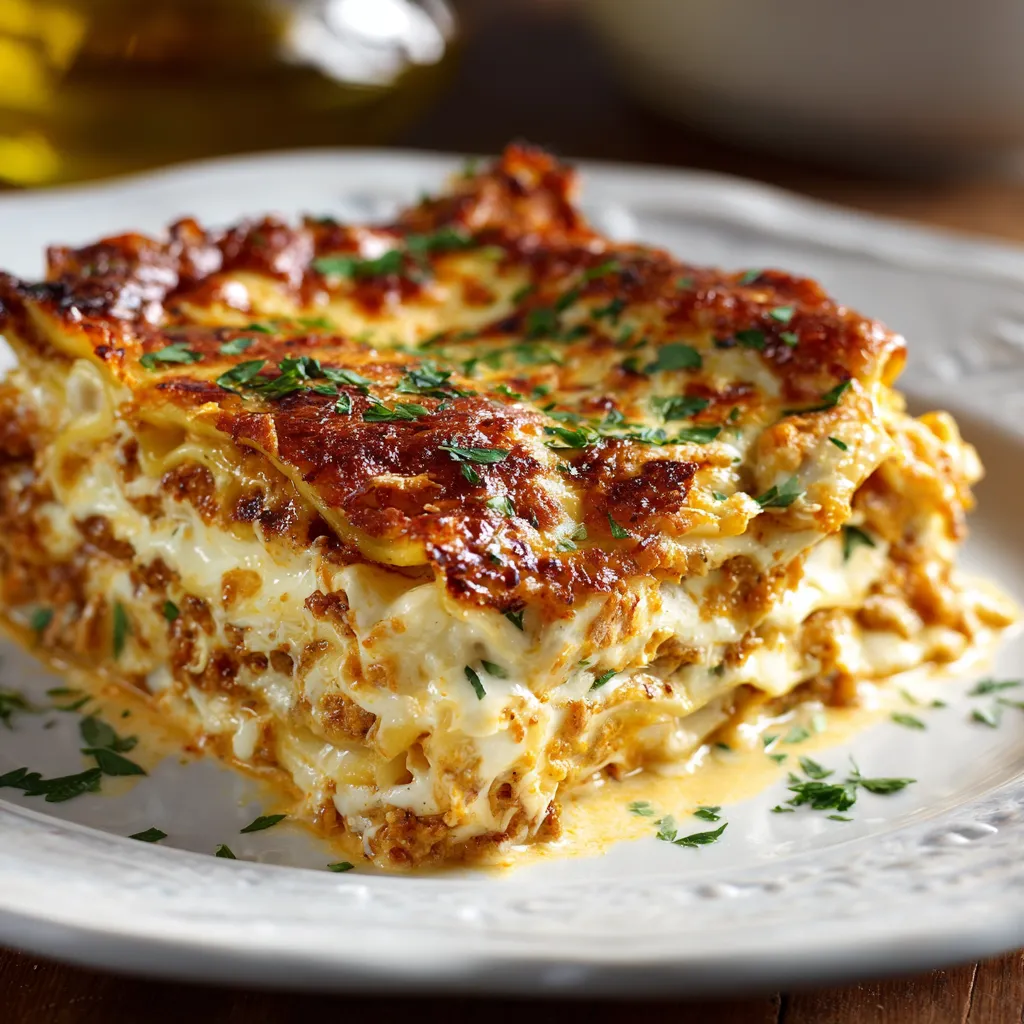
What is the San Giorgio Lasagna Recipe?
The San Giorgio lasagna recipe is a traditional lasagna preparation that gained widespread popularity due to its inclusion in San Giorgio pasta packaging. San Giorgio, an established pasta brand in the United States since the early 20th century, provided an easy-to-follow, classic Italian lasagna recipe printed on their boxes, making it accessible for home cooks.
This recipe typically features layers of pasta sheets, a rich meat sauce (ragù), creamy béchamel, and cheese baked to golden perfection. It’s celebrated for its simplicity, balanced flavours, and nostalgic comfort it offers.
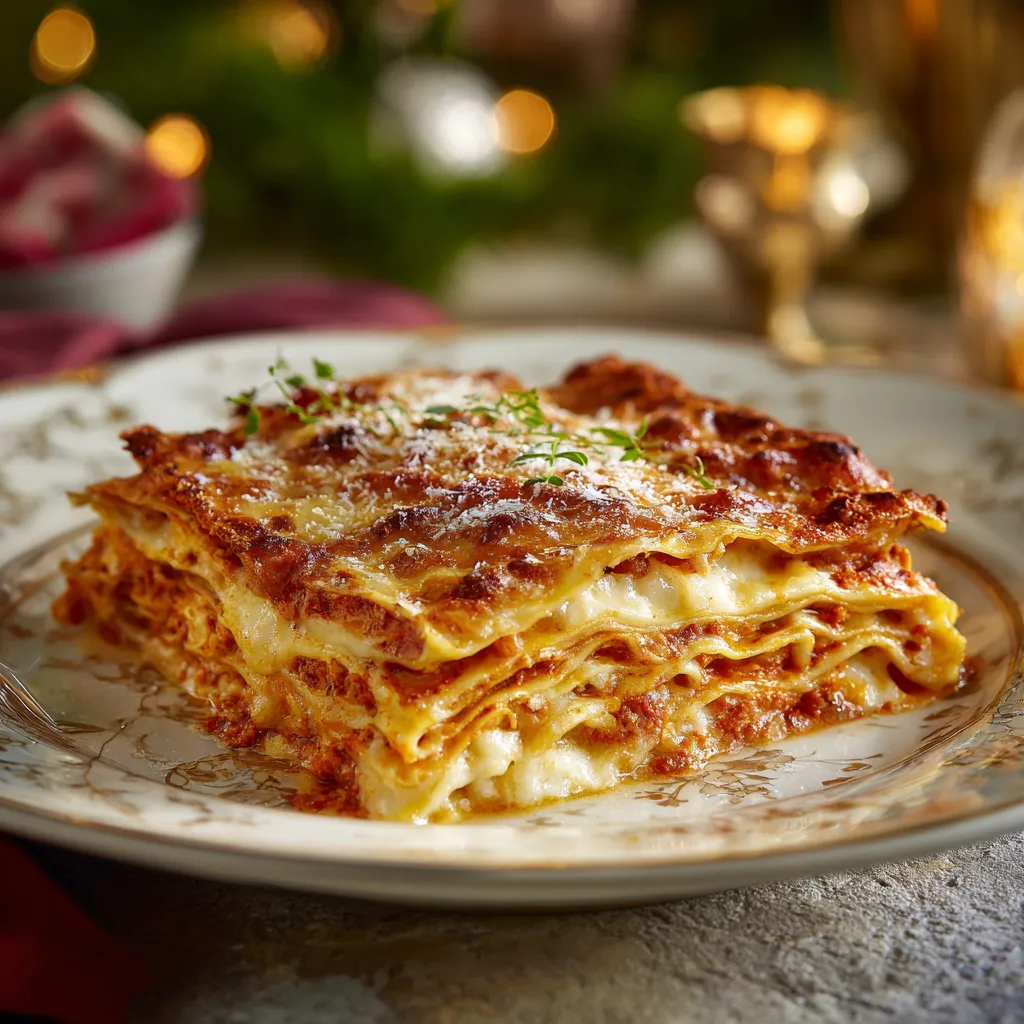
If you want to explore the authentic Italian roots and cooking techniques behind lasagna, resources like The Spruce Eats provide in-depth insights into Italian lasagna varieties.
The History Behind San Giorgio Lasagna Recipe Box
San Giorgio pasta has been a staple brand in American kitchens for nearly a century. The San Giorgio lasagna recipe on the box was designed as a user-friendly guide to help consumers recreate classic Italian dishes with ease. This recipe brought traditional Italian cuisine to the American public during a time when Italian food was less mainstream.
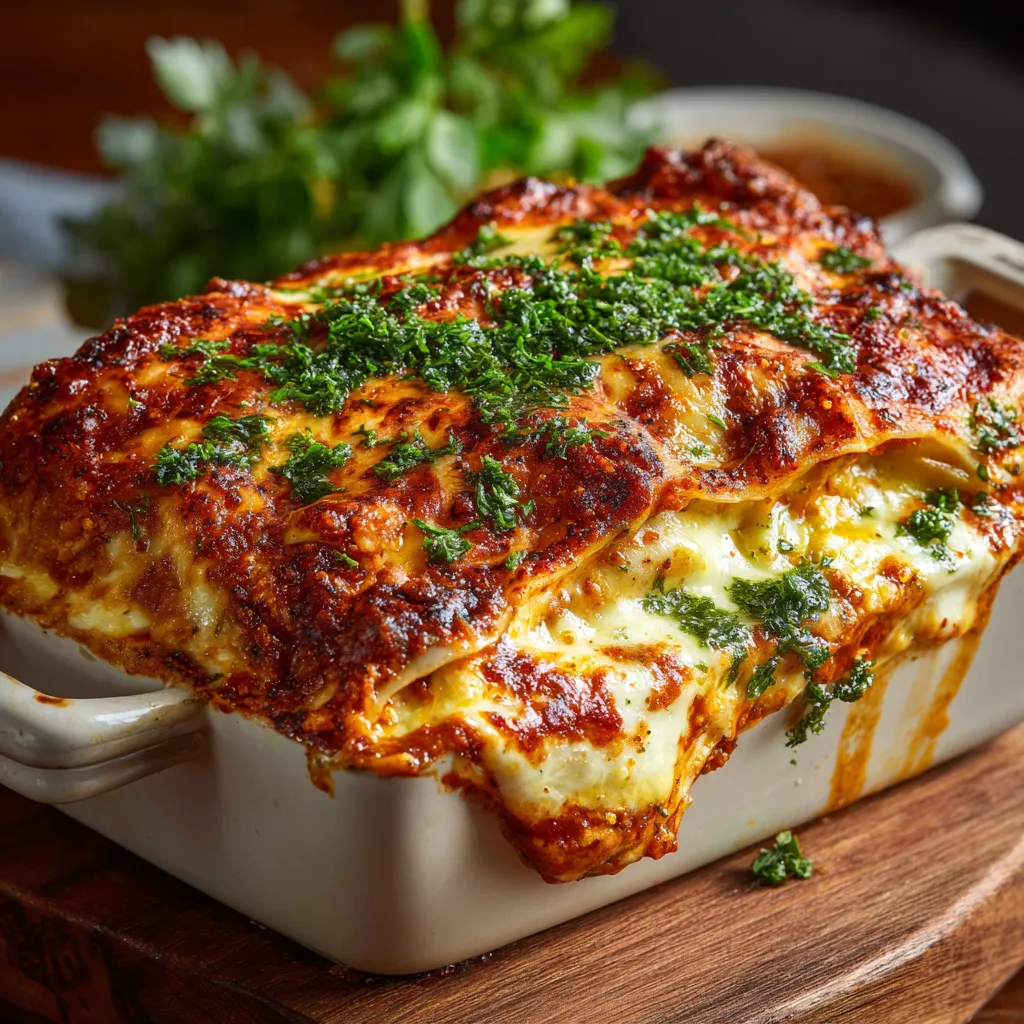
Many families still cherish this recipe as a nostalgic heirloom, passing it down through generations. Its straightforward approach — combining accessible ingredients and clear instructions — helped popularize lasagna in the United States.
For a deeper dive into San Giorgio’s history, see the Food History Timeline.
Ingredients and Preparation
Ingredients for the San Giorgio Lasagna Recipe
- 1 package of San Giorgio lasagna noodles (or any quality lasagna pasta)
- 1 lb ground beef or Italian sausage
- 1 jar (24 oz) marinara sauce or homemade tomato sauce
- 2 cups ricotta cheese
- 2 cups shredded mozzarella cheese
- 1/2 cup grated Parmesan cheese
- 2 eggs
- 2 tablespoons olive oil
- 1 medium onion, finely chopped
- 3 cloves garlic, minced
- 1 teaspoon dried basil
- 1 teaspoon dried oregano
- Salt and pepper to taste
- Fresh parsley or basil for garnish (optional)
Preparation Tips Before Cooking
- Boil the lasagna noodles until al dente (firm but cooked). Some recipes allow no-boil noodles, but the original San Giorgio recipe calls for boiling.
- Preheat the oven to 375°F (190°C).
- Mix the ricotta cheese with eggs, Parmesan cheese, and parsley to create a creamy cheese layer.
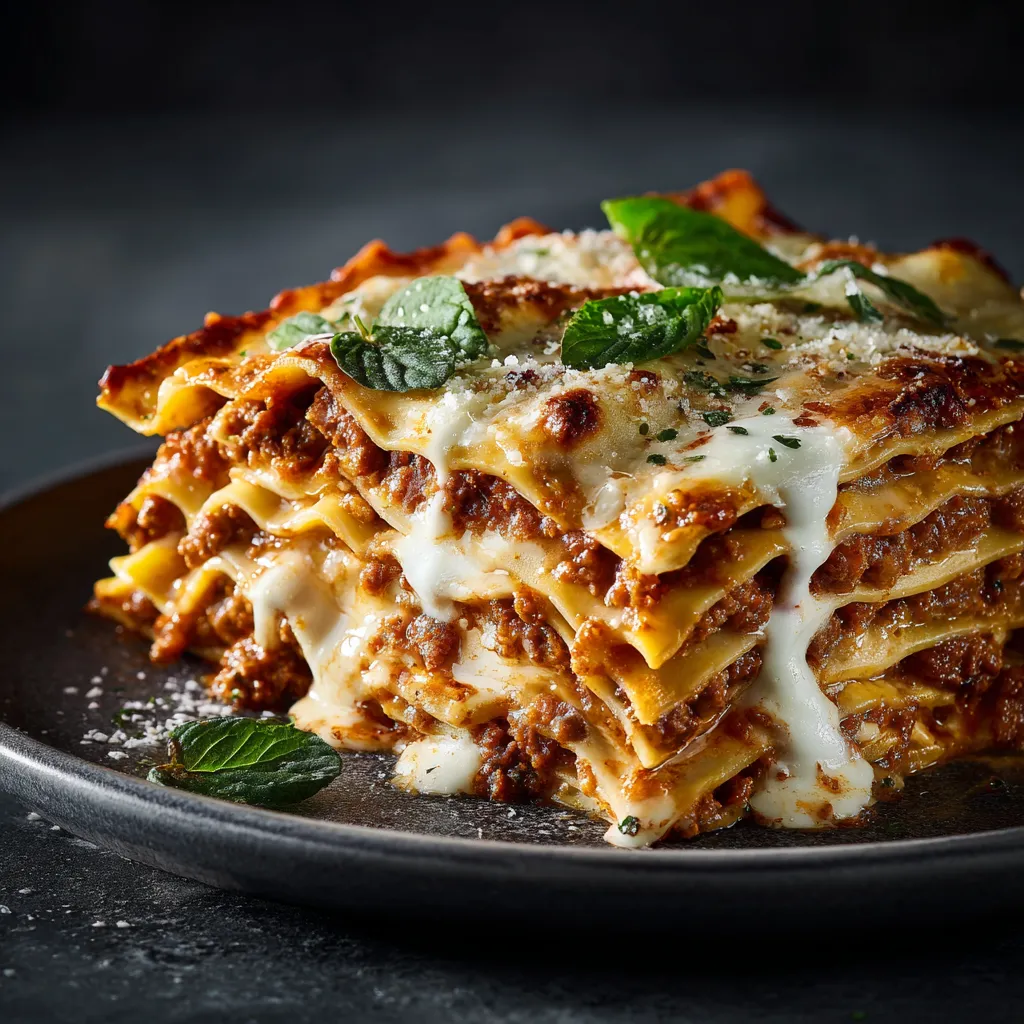
Step-by-Step San Giorgio Lasagna Recipe
Follow these steps to recreate the classic San Giorgio lasagna recipe box style:
Step 1: Prepare the Meat Sauce
- Heat olive oil in a large skillet over medium heat.
- Add chopped onions and sauté until translucent (about 5 minutes).
- Add garlic and cook for another minute until fragrant.
- Add ground beef or sausage, breaking it apart with a spoon. Cook until browned and no longer pink.
- Stir in marinara sauce, dried basil, oregano, salt, and pepper.
- Simmer for 15-20 minutes, allowing flavours to meld.
Step 2: Prepare the Cheese Mixture
- In a bowl, combine ricotta cheese, eggs, Parmesan cheese, and fresh parsley. Mix well.
Step 3: Assemble the Lasagna
- Spread a thin layer of meat sauce on the bottom of a 9×13-inch baking dish.
- Layer noodles to cover the sauce completely.
- Spread a layer of the ricotta cheese mixture over the noodles.
- Add a layer of meat sauce over the cheese.
- Sprinkle shredded mozzarella cheese generously.
- Repeat layers (noodles, ricotta mixture, meat sauce, mozzarella) until ingredients are used up, finishing with a mozzarella layer.
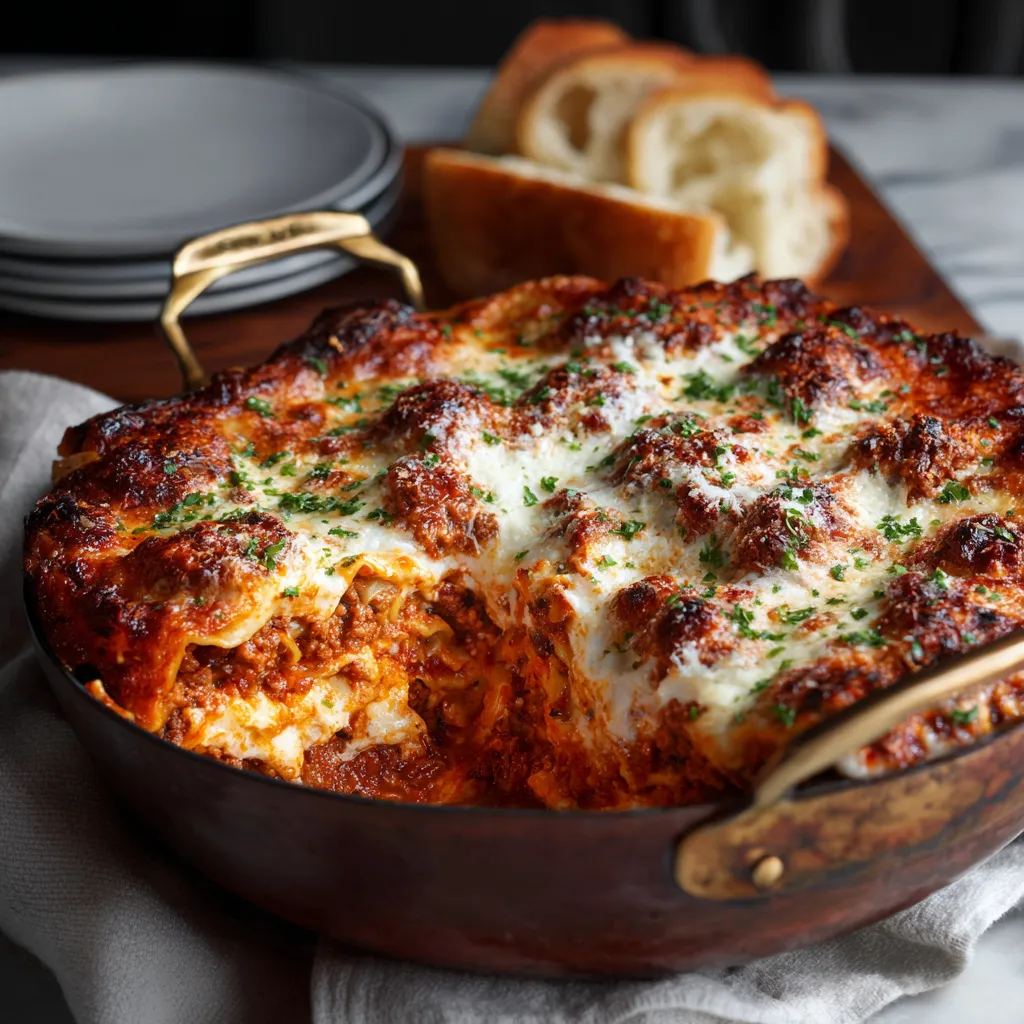
Step 4: Bake the Lasagna
- Cover the dish with aluminium foil (tenting it so it doesn’t touch the cheese).
- Bake in the preheated oven for 25 minutes.
- Remove the foil and bake for an additional 25 minutes until bubbly and golden on top.
- Let it rest for 10-15 minutes before serving.
Tips for Perfect Lasagna Every Time
- Use quality San Giorgio lasagna noodles for authentic texture.
- Don’t overcook noodles to avoid mushy layers.
- Simmer meat sauce for longer to deepen the flavour.
- Let the lasagna rest after baking for clean slices.
- Add fresh herbs like basil or oregano for enhanced aroma.
- Use whole milk ricotta for a creamier texture.
- For added richness, stir a bit of béchamel sauce in with the ricotta.
These tips ensure your lasagna matches the delightful taste of the San Giorgio lasagna recipe box.
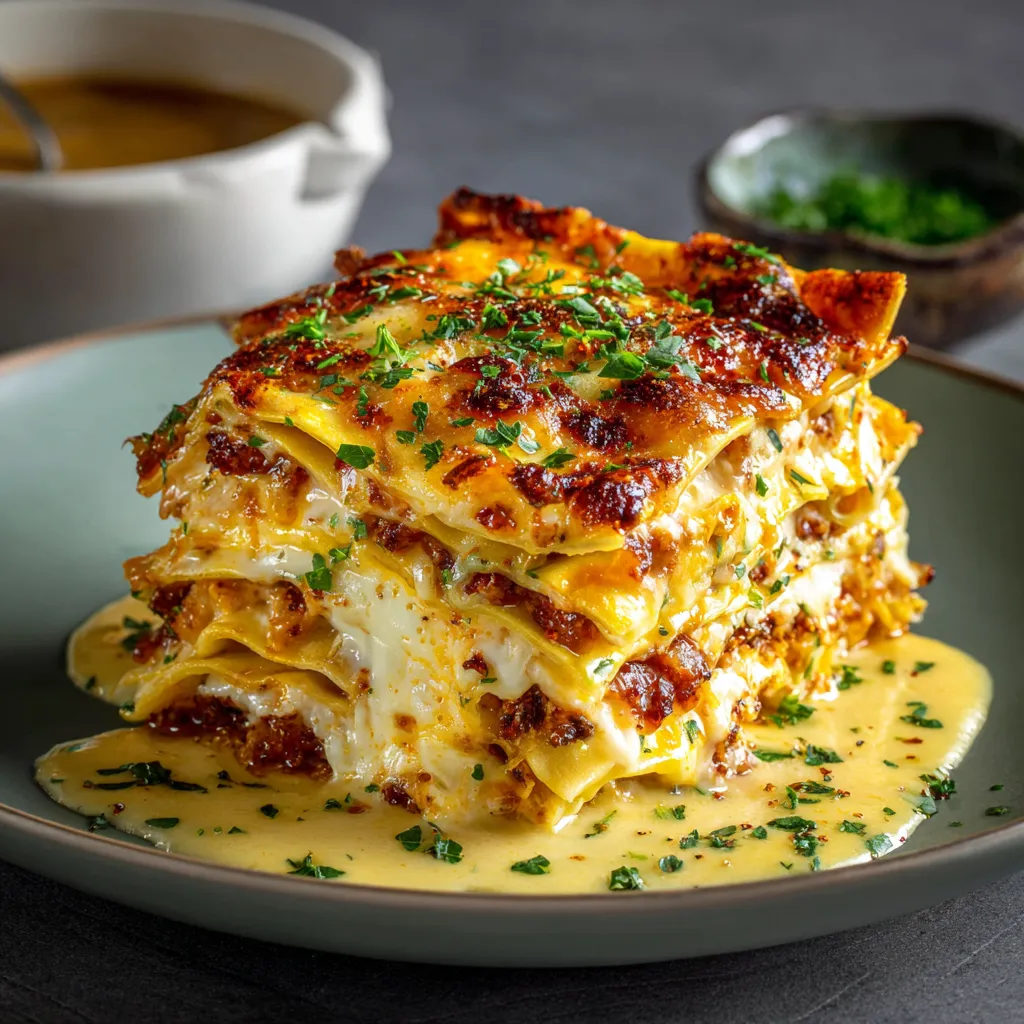
Common Challenges and How to Fix Them
ChallengeCauseSolution
Soggy noodles Overboiling pasta or too much sauce Cook noodles al dente; drain well; moderate sauce
Dry lasagna: Insufficient sauce or cheese layers Add more sauce between layers; don’t skimp on cheese.
The lasagna falls apart. There is No resting time before slicing Let it cool for 10-15 minutes to set
Burnt top Baking uncovered for too long Cover with foil during the first baking stage
Uneven cooking Uneven layering or oven hotspots Spread layers evenly; rotate dish halfway baking
By anticipating these challenges, you can perfect your lasagna effortlessly.
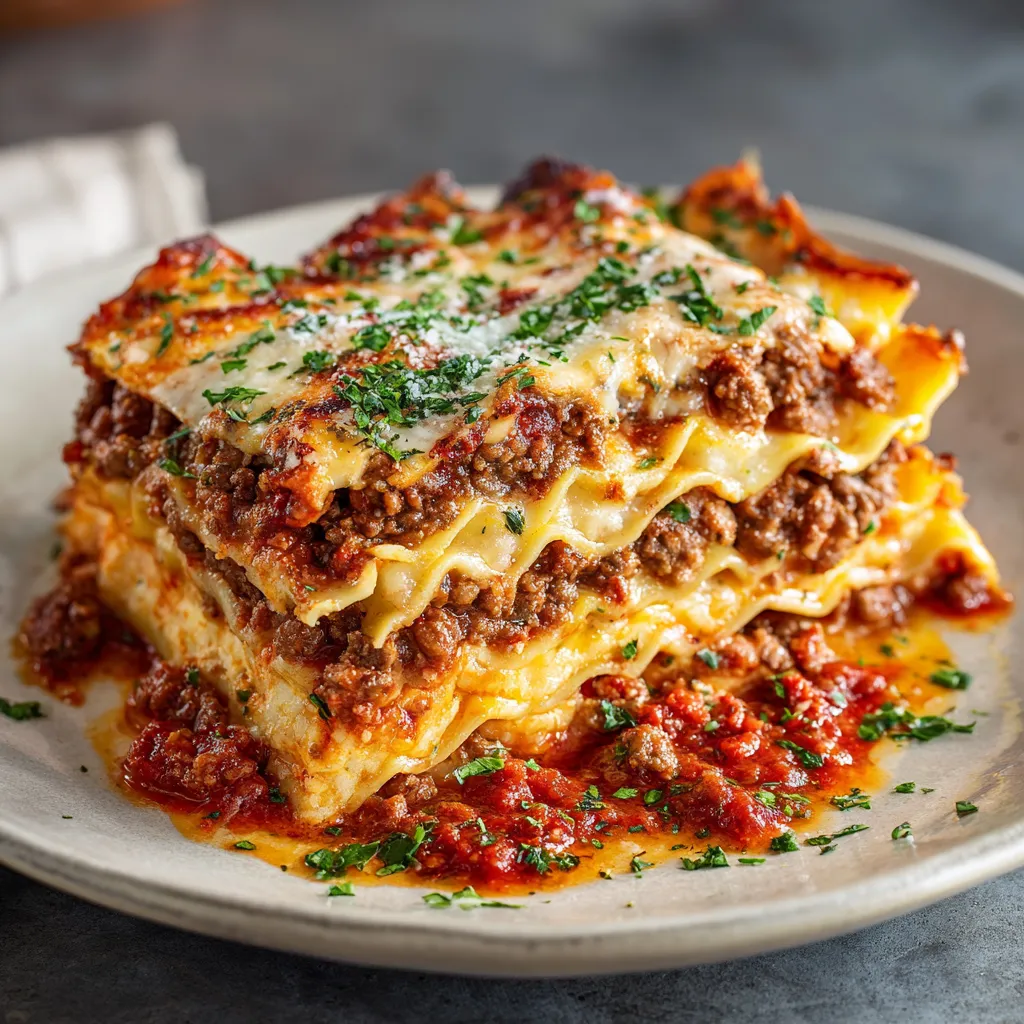
Nutritional Information and Health Benefits
A typical serving (1/8 of a 9×13 dish) of San Giorgio-style lasagna contains approximately:
NutrientAmount
Calories 450-550 kcal
Protein 25-30 grams
Carbohydrates 35-45 grams
Fat 20-25 grams
Fiber 3-5 grams
Sodium 600-800 mg
Lasagna offers a balanced meal with proteins, carbs, and fats. Using lean meat and fresh ingredients enhances its nutritional profile. It’s also a comfort food that boosts mood and satisfies cravings.
For those interested in healthier alternatives, check Harvard’s Healthy Eating Plate for balanced meal ideas.

Tools and Equipment You’ll Need
- Large pot (for boiling noodles)
- Large skillet or saucepan (for meat sauce)
- Mixing bowls (for cheese mixture)
- 9×13-inch baking dish (glass or ceramic preferred)
- Aluminium foil
- Wooden spoon and spatula
- Cheese grater
- Oven mitts
These basic kitchen tools will make the lasagna preparation smooth and enjoyable.
Variations on the San Giorgio Lasagna Recipe
You can customize this classic recipe in many ways:
- Vegetarian Version: Replace meat with sautéed mushrooms, zucchini, spinach, or lentils.
- White Sauce Lasagna: Use béchamel sauce instead of tomato-based meat sauce for a creamy texture.
- Seafood Lasagna: Incorporate shrimp, crab, or white fish with a light cream sauce.
- Gluten-Free Lasagna: Use gluten-free pasta sheets or thinly sliced vegetables like zucchini or eggplant as noodles.
- Spicy Lasagna: Add red pepper flakes or spicy sausage for a kick.
These options let you tailor the dish to dietary needs or preferences without losing the essence of the San Giorgio style.
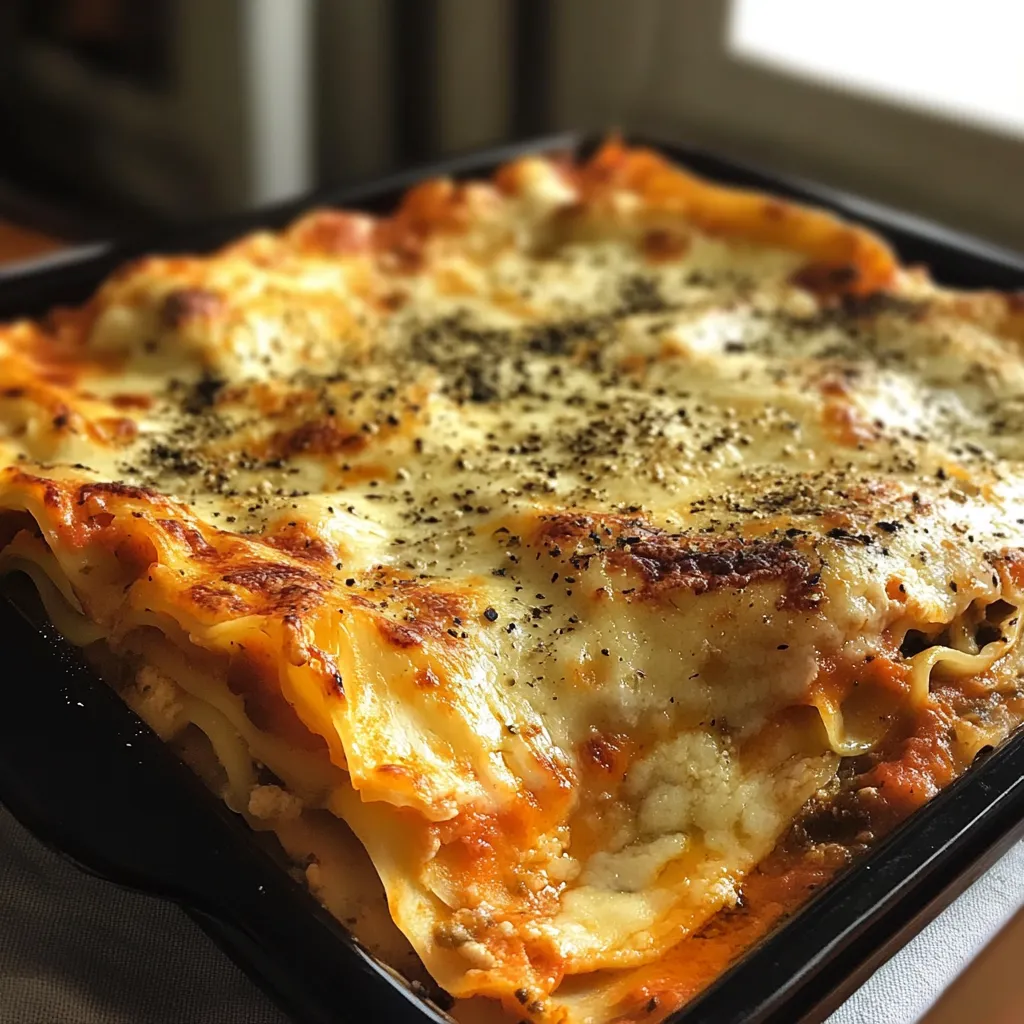
Frequently Asked Questions About San Giorgio Lasagna Recipe
1. What is the San Giorgio lasagna recipe, and why is it so popular?
The San Giorgio lasagna recipe is a classic Italian-American recipe printed on San Giorgio pasta boxes for decades. It features layers of pasta sheets, a savoury meat sauce, ricotta and mozzarella cheese, and Parmesan, baked to a bubbling golden finish. Its popularity stems from its simplicity, authentic taste, and ease of preparation. For many, it represents a nostalgic, family-friendly meal passed down through generations.
San Giorgio’s reputation as a trusted pasta brand helped this recipe become a staple in many kitchens. The recipe bridges traditional Italian flavours with accessible ingredients, making it perfect for home cooks who want a taste of Italy without complex steps.
Learn more about Italian pasta brands and their heritage at Fine Cooking.
2. How do I make the San Giorgio lasagna recipe authentic and flavorful?
Authenticity in the San Giorgio lasagna recipe comes from using quality ingredients and following traditional layering techniques. Start with San Giorgio lasagna noodles or another quality pasta brand to maintain the right texture. Use a homemade or good-quality marinara sauce and fresh herbs like basil and oregano to enhance flavour.
Browning the ground meat correctly adds depth, and combining ricotta with eggs and Parmesan ensures a creamy cheese layer. Simmering the sauce long enough allows the flavours to meld, giving you a rich and savoury filling. Finally, baking covered and uncovered guarantees a moist interior with a golden, bubbly crust.
For detailed tips on making authentic lasagna, see Serious Eats’ Classic Lasagna Guide.
3. Can I make the San Giorgio lasagna recipe vegetarian-friendly?
Absolutely! While the classic San Giorgio lasagna recipe includes meat, it can easily be adapted to a vegetarian version. Replace the ground beef or Italian sausage with sautéed vegetables such as mushrooms, zucchini, spinach, or eggplant.
For added protein, you can incorporate lentils or plant-based meat substitutes. Use a rich tomato sauce or add a béchamel (white) sauce layer for creaminess. This approach keeps the hearty texture and layered goodness while catering to vegetarian diets.
Explore more vegetarian lasagna recipes at The Spruce Eats.
4. What kind of noodles should I use for the San Giorgio lasagna recipe?
The original San Giorgio lasagna recipe on the box recommends boiling lasagna noodles until al dente — tender but still firm to the bite. San Giorgio brand noodles are preferred for authenticity, but any quality lasagna pasta works well.
No-boil or oven-ready noodles are convenient alternatives; however, you may need to adjust the amount of sauce to ensure they cook properly during baking. Overcooking noodles can cause sogginess while undercooking will make the lasagna chewy, so aim for that perfect al dente texture.
For insights on pasta types and cooking, check Bon Appétit’s Pasta Guide.
5. How long does it take to prepare and bake the San Giorgio lasagna recipe?
Preparation time for the San Giorgio lasagna recipe generally ranges from 30 to 45 minutes, including boiling noodles, preparing the meat sauce, and assembling the layers. The baking process takes about 50 minutes — 25 minutes to be covered and 25 minutes to be uncovered to brown the top.
After baking, resting the lasagna for 10-15 minutes is essential to let it set, which helps with slicing and serving. In total, expect about 1.5 hours from start to finish.
Learn more about cooking times and tips at Allrecipes’ Lasagna Cooking Tips.
6. What are the best cheeses to use in the San Giorgio lasagna recipe?
Classic cheese choices for this recipe include ricotta, mozzarella, and Parmesan.
- Ricotta cheese provides a creamy, slightly sweet base that balances the tomato sauce.
- Mozzarella cheese adds meltiness and gooey texture. Fresh mozzarella is ideal, but shredded works too.
- Parmesan cheese offers a sharp, nutty flavour that enhances the overall taste.
Using fresh, high-quality cheeses will significantly improve the final dish’s flavour and texture.
For cheese selection advice, visit Cheese Science at Culture Cheese Magazine.
7. Can I freeze San Giorgio lasagna, and how should I do it?
Yes, freezing the San Giorgio lasagna recipe is an excellent way to save leftovers or prepare meals in advance.
To freeze:
- Assemble the lasagna in a freezer-safe dish.
- Cover tightly with plastic wrap and aluminium foil to prevent freezer burn.
- Label with the date.
To reheat:
- Thaw overnight in the refrigerator.
- Bake at 350°F (175°C), covered with foil, for 30-40 minutes or until heated through and bubbly.
- Remove foil in the last 10 minutes to brown the top.
Frozen lasagna may lose a bit of texture but retains great flavour and convenience.
Check out The Kitchn’s Guide on Freezing Lasagna.
8. How can I prevent my lasagna from becoming soggy?
A soggy lasagna is a common issue but easy to avoid with these tips:
- Cook noodles al dente so they don’t over-soften during baking.
- Drain noodles thoroughly and avoid adding too much sauce. The sauce should be moist but not watery.
- Use a sturdy baking dish and bake covered at first, then uncovered to allow moisture evaporation.
- Let the lasagna rest for 10-15 minutes after baking to let excess moisture absorb and layers set.
Following these steps will give you a firm, sliceable lasagna that holds together perfectly.
More tips on avoiding soggy lasagna are available at Epicurious.
9. What side dishes complement the San Giorgio lasagna recipe?
The rich, hearty nature of the San Giorgio lasagna recipe pairs well with lighter, fresh side dishes such as:
- Crisp Caesar or mixed green salad with vinaigrette.
- Garlic bread or crusty Italian bread to soak up the sauce.
- Roasted or steamed vegetables like broccoli, asparagus, or green beans.
- Simple antipasto platter featuring olives, artichokes, and cured meats for an Italian flair.
These sides balance the meal, adding freshness and variety.
Get inspired by side dish ideas at Food Network’s Italian Side Dishes.
10. Can I prepare the San Giorgio lasagna recipe ahead of time?
Yes! The San Giorgio lasagna recipe is ideal for meal prep and can be assembled a day in advance. After forming, cover the dish tightly and refrigerate. Baking just before serving ensures fresh, hot lasagna.
Some cooks find that letting the assembled lasagna rest in the fridge overnight helps the flavours meld and improves slicing consistency.
For meal prep ideas, visit Taste of Home’s Make-Ahead Lasagna Tips.
11. How can I make the San Giorgio lasagna recipe healthier?
To make a healthier version of the classic San Giorgio lasagna recipe:
- Use lean ground turkey or chicken instead of beef or sausage.
- Increase the amount of vegetables like spinach, mushrooms, or zucchini.
- Substitute part-skim ricotta or cottage cheese for full-fat ricotta.
- Use whole wheat or gluten-free pasta if desired.
- Limit added salt and use low-sodium marinara sauce.
These adjustments reduce calories and fat while maintaining delicious flavours.
For more healthy Italian recipes, check EatingWell’s Healthy Lasagna Ideas.
12. Is it necessary to use eggs in the ricotta cheese mixture for the San Giorgio lasagna recipe?
Including eggs in the ricotta cheese mixture helps bind the cheese layer, making it firmer and less likely to separate during baking and slicing. While not strictly required, eggs contribute to the texture and structure of the lasagna.
If you prefer an egg-free version, you can omit them but expect a slightly softer cheese layer.
Read about the role of eggs in lasagna in Cook’s Illustrated.
13. What is the best way to store leftover San Giorgio lasagna?
Store leftovers in an airtight container in the refrigerator for up to 3-4 days. To reheat, microwave individual portions or warm in an oven at 350°F covered with foil until heated through.
For more extended storage, freeze as described earlier.
See storage and reheating tips at Still Tasty.
14. How do I ensure even cooking in my San Giorgio lasagna recipe?
To ensure even cooking:
- Use a baking dish that allows heat to distribute evenly (glass or ceramic is preferred).
- Spread sauce and cheese layers uniformly.
- Avoid overly thick layers that can remain undercooked.
- Rotate the baking dish halfway through cooking if your oven has hot spots.
Even layering and proper baking times guarantee that every slice is perfectly cooked.
Learn more at Serious Eats’ Baking Tips.
15. Where can I find the San Giorgio lasagna recipe printed on the box?
The San Giorgio lasagna recipe box has been included on San Giorgio lasagna pasta packaging for decades. While not all current packages may have the recipe, vintage boxes or scans can be found online through cooking forums and recipe archives.
Many websites and food blogs also reproduce this classic recipe to preserve its tradition, such as AllRecipes and Food Network.
16. Can I use San Giorgio lasagna noodles for no-boil recipes?
San Giorgio lasagna noodles are traditionally designed to be boiled before layering in the recipe. They are standard dry pasta sheets, which need pre-cooking to achieve the right texture and avoid dryness or undercooked pasta layers.
However, if you want to skip boiling, you can try a no-boil recipe, but this requires extra sauce or liquid to hydrate the noodles as they cook in the oven. Some cooks substitute San Giorgio noodles with special no-boil varieties designed to absorb moisture during baking.
No-boil noodles save time but may alter the texture slightly. If using San Giorgio noodles without boiling, make sure your sauce is quite saucy and cover the lasagna tightly while baking.
For more on no-boil vs boiled noodles, check out this detailed comparison at The Kitchen.
17. How does San Giorgio’s lasagna recipe compare to other classic lasagna recipes?
San Giorgio’s recipe is widely praised for its straightforward, family-friendly approach. Compared to other classic lasagna recipes like Bolognese or vegetarian versions, San Giorgio focuses on simplicity, with layers of meat sauce, ricotta, mozzarella, and Parmesan.
Unlike lasagnas with béchamel sauce (white sauce), the San Giorgio recipe relies heavily on tomato-based sauce and cheese layers. It is considered more accessible for home cooks who want classic Italian-American comfort food without complex techniques.
If you want to explore classic Italian lasagnas, Serious Eats offers an excellent guide to various traditional recipes from Italy’s regions.
18. What type of meat works best in the San Giorgio lasagna recipe?
Ground beef is the classic choice in the San Giorgio lasagna recipe, often mixed with pork or Italian sausage to add richness and flavour. Using an 80/20 ratio (80% lean meat to 20% fat) provides enough fat for taste without excessive greasiness.
For a leaner version, ground turkey or chicken can be substituted, but the flavour will be lighter. Mixing in finely chopped mushrooms or vegetables can boost flavour and moisture as well.
Browning the meat well before combining it with tomato sauce adds depth through caramelization.
Learn more about choosing the right ground meat at Eat This, Not That!
19. Is it necessary to use fresh herbs in the San Giorgio lasagna recipe?
Fresh herbs like basil, oregano, and parsley can significantly enhance the flavour profile of your San Giorgio lasagna recipe. While dried herbs are acceptable and convenient, fresh herbs add a bright, aromatic freshness that dried versions cannot fully replicate.
You can add fresh herbs to your sauce, cheese mixture, and as a garnish. If fresh herbs are unavailable, use good quality dried herbs, but reduce the quantity since dried herbs are more concentrated.
For tips on substituting fresh and dried herbs, check out The Spruce Eats.
20. How do I know when my San Giorgio lasagna is perfectly cooked?
Signs that your San Giorgio lasagna is perfectly cooked include:
- Bubbly sauce visibly simmering around the edges of the dish.
- A golden-brown crust forms on the top cheese layer.
- The internal temperature reaches around 165°F (74°C) if using a food thermometer.
- The lasagna feels firm to the touch and slices cleanly without falling apart.
Resting the lasagna for 10-15 minutes post-baking allows it to set further, ensuring neat slices and ideal texture.
For more cooking time tips, visit Food Network.
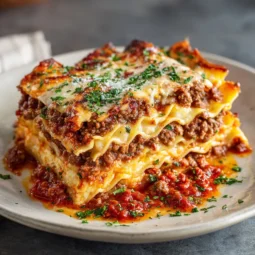
San Giorgio Lasagna Recipe
Equipment
- 13×9-inch baking dish
- Large pot
- Medium saucepan
- Skillet
- Wooden spoon
- Mixing bowls
- Measuring cups & spoons
- Aluminum foil
- Oven
Ingredients
- For the Lasagna:
- 1 box 16 oz San Giorgio® Lasagna noodles
- 1 pound ground beef or Italian sausage
- 1 jar 24 oz marinara or pasta sauce
- 1 container 15 oz ricotta cheese
- 2 cups shredded mozzarella cheese
- ½ cup grated Parmesan cheese
- 1 large egg
- 2 tablespoons chopped parsley optional
- Salt and pepper to taste
- Optional Add-ins:
- Sautéed spinach or mushrooms
- Red pepper flakes for spice
- Fresh basil or oregano
Instructions
- Step 1: Cook the Pasta
- Boil San Giorgio Lasagna noodles according to package instructions. Drain and lay flat on parchment paper or foil to prevent sticking.
- Step 2: Prepare the Meat Sauce
- In a skillet over medium heat, cook ground beef until browned. Drain fat, add marinara sauce, and simmer for 10 minutes. Season with salt, pepper, and herbs.
- Step 3: Make the Ricotta Mixture
- In a bowl, mix ricotta cheese, beaten egg, Parmesan, and chopped parsley (if using). Set aside.
- Step 4: Preheat the Oven
- Preheat your oven to 375°F (190°C).
- Step 5: Assemble the Lasagna
- In a 13×9″ baking dish:
- Spread 1 cup of sauce on the bottom
- Add a layer of noodles
- Spread ricotta mixture
- Sprinkle mozzarella
- Add meat sauce
- Repeat layers (3 total), ending with sauce and mozzarella
- Step 6: Bake
- Cover with foil and bake for 25 minutes. Remove foil and bake another 20 minutes until cheese is bubbly and golden.
- Step 7: Rest and Serve
- Let lasagna rest for 10–15 minutes before slicing. Garnish with fresh basil or more Parmesan if desired.
Notes
Other delicious recipes you can check out that you might like:
